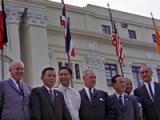What happened that day?
See historic events for any day of the year by entering the date below. Why not try your birthday?
Kiwi of the Week
Today in History

1954 NZ signs Manila Pact
The South-East Asia Collective Defence Treaty, or Manila Pact, aimed to contain the spread of communism in the region. The South-East Asia Treaty Organisation (SEATO) was the institutional expression of this Treaty.
The signatories to the Manila Pact were Australia, Britain, France, New Zealand, Pakistan, the Philippines, Thailand and the United States. The treaty was signed in the same year that US President Dwight Eisenhower made his famous ‘Domino Theory’ speech, in which he outlined growing concern over communist influence in Indochina and the wider region. The US called upon willing partners in the region to stand up to the communists.
New Zealand had already felt the impact of the Cold War and its associated armed conflicts. In the Korean War, which erupted in 1950, New Zealand showed its commitment to the United Nations and collective security, and to US attempts to contain the spread of communism. This policy was further demonstrated by the signing of security treaties such as ANZUS (1951) and the Manila Pact as New Zealand followed a policy of alliance-based security.
SEATO was established in February 1955. Its combination of powers from outside the area and pro-Western nations from within the region could be described as an attempt to establish a South-East Asian version of NATO. But unlike the NATO alliance, SEATO had no joint command or standing forces. An attack on one member was not automatically considered an attack on all. Each member could effectively block any collective SEATO action. As French and British interests in the region declined, SEATO's effectiveness as a collective security organisation was debatable. When war broke out again in Indochina, SEATO was unable to reach a consensus on intervention.
The US tried unsuccessfully to make the Vietnam War a SEATO collective defence problem. While the US, Australian and New Zealand governments used SEATO to justify their involvement in Vietnam, the organisation did not act collectively in this war, which some of its members opposed.
SEATO was dissolved in June 1977.
Image: the leaders of SEATO in 1966 - NZ Prime Minister Keith Holyoake is fourth from the right (Wikipedia)














